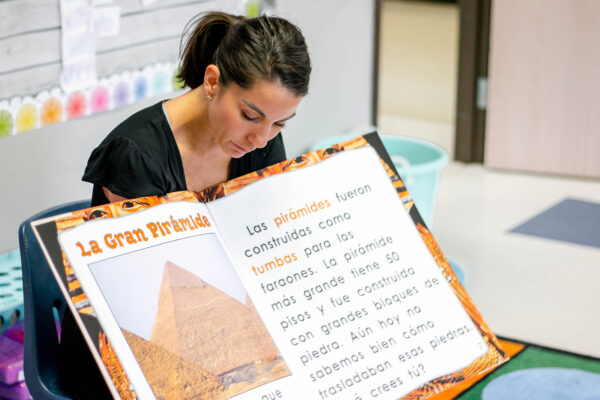Do you know about the 10,000 hour rule? It is said that it takes practicing something for 10,000 hours in order to become proficient at it. Whether or not it is truly 10,000 hours, there is something to be said about practice. It’s the way our minds and bodies participate in creating and developing skills.
When applying this concept to the English Learner, it’s encouraging to conclude that a little bit each day will eventually lead to proficient bilingualism. But it doesn’t come without practice. The classroom is an effective incubator for practicing, failing, guessing, and ultimately learning a new language. And language is acquired, sometimes quickly, sometimes slowly, but by each hour nonetheless. But just as a child’s home environment will have an effect on their daily life, their classroom environment will too.
Studies show that effective literacy instruction for English Learners requires a certain environment for learning to thrive. Even more recently, studies indicate that a language-rich classroom creates the best atmosphere for English Learners to grow and develop their oral language and literacy skills. One of the best ways to achieve that is through reading aloud every single day, from multiple genre materials, and in multiple languages.
Reading Aloud to Promote a Language RIch Environment
Reading aloud has many benefits. It gives students a chance to hear content-rich materials in their own language from their teacher each day. There are sounds they can hone in on and glance at a word wall to make sense of it. Phonics and graphemes become tools to achieve comprehension rather than a stand alone lesson. Pictures, if anything, can communicate the building blocks of language. Sight words are absorbed, vocabulary words are utilized, and spontaneous responses are allowed. Hour by hour, day by day, learning seeps in and is nurtured by the classroom environment.
A common pitfall in order to quickly develop the literacy component of English Learners is to drill phonics based materials without content or comprehension. In doing so, English Learners can understand the mechanism of decoding, but cannot explain the word. Reading Aloud before practicing reading can help to prime the child’s neural pathways of comprehension (and the same goes for handwriting!). Cognitive theories support the idea of the phonological loop, in which the working memory holds on to words heard and seen, and can be manipulated in real time for meaning-making when the time comes. Amazing stuff!
So, when a book is read aloud, and then reinforced by visuals on the wall, and later in the day, when a book with similar materials, but perhaps coming from another genre can be grabbed off the shelf by the student, all of the hard work required for effective literacy instruction is brought to life with the richness of language surrounding the student. This can be very simple. Choosing the right materials at the right time can help the student, one hour at a time, one day at a time, and maybe in 10,000 hours, their language truly begins to bloom.




